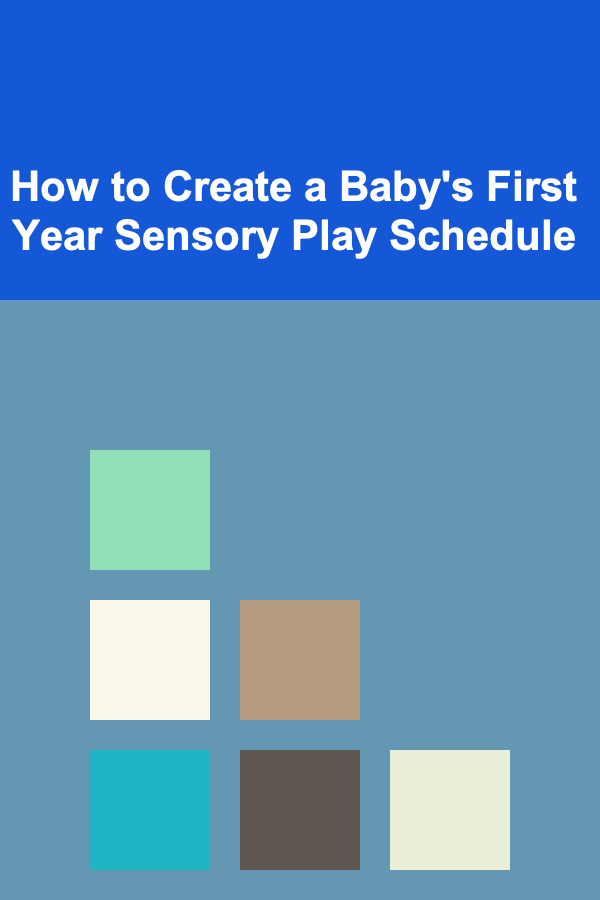
How to Create a Baby's First Year Sensory Play Schedule
ebook include PDF & Audio bundle (Micro Guide)
$12.99$8.99
Limited Time Offer! Order within the next:

The first year of a baby's life is a period of immense growth and development. During this time, babies' brains are incredibly receptive to new experiences, and sensory play is a vital part of their learning process. Sensory play allows babies to explore the world around them, stimulating their senses and helping them make connections that form the foundation of their cognitive, physical, and emotional growth.
Creating a sensory play schedule for a baby's first year involves balancing activities that stimulate different senses---sight, sound, touch, taste, and smell---while also considering developmental milestones and the baby's individual needs. The key is to introduce varied activities at appropriate developmental stages, creating an environment that encourages exploration and curiosity.
In this guide, we will explore the importance of sensory play, how to create a sensory play schedule, and how to adapt it as your baby grows throughout their first year.
Understanding the Importance of Sensory Play
Sensory play is essential for babies as it helps them develop their sensory processing skills, motor coordination, and cognitive abilities. Babies are born with the ability to perceive the world through their senses, and sensory play allows them to use those senses to learn more about their surroundings.
Benefits of Sensory Play
-
Cognitive Development
- Sensory play helps babies learn to process and respond to different stimuli. They begin to understand cause and effect, recognize patterns, and develop problem-solving skills.
-
Motor Skills
- Handling objects, reaching for toys, and experimenting with different textures and sounds help babies build fine and gross motor skills. Grasping, manipulating, and moving are essential milestones during the first year.
-
Emotional Growth
- Sensory play can have a calming effect on babies. Familiar toys and activities can bring comfort, while novel experiences can encourage curiosity and help babies become more resilient to stress.
-
Social Interaction
- Sensory play is often an interactive experience. Whether it's playing with parents, caregivers, or other children, these activities promote social bonding and communication development.
-
Language Development
- Engaging in sensory play exposes babies to new words and concepts, which can boost their early language development. Through sensory play, they learn to associate sounds, actions, and objects with language.
Creating a Sensory Play Schedule
When developing a sensory play schedule, it's important to consider the following factors:
- Age and Developmental Stage: The types of activities that are suitable will change as your baby grows. Sensory play should be adjusted to match your baby's abilities at each stage.
- Duration of Activities: Babies' attention spans are short, so sensory play sessions should be brief but frequent. It's more effective to engage in short bursts of activity throughout the day than to expect long sessions of play.
- Variety: Offer a range of sensory experiences to stimulate all five senses---sight, sound, touch, taste, and smell. This ensures a well-rounded developmental experience.
Here's how you can break down sensory play activities throughout your baby's first year:
2.1 Months 0--3: Early Sensory Exploration
During the first three months, babies are still adjusting to life outside the womb, so their senses are developing gradually. At this stage, the focus should be on gentle sensory experiences that don't overwhelm the baby.
Sensory Play Ideas:
- Touch: Soft fabrics, like cotton or fleece, can be introduced for babies to touch during tummy time. You can gently rub their hands and feet with textured materials.
- Sight: High-contrast patterns and colors (black, white, and red) are easiest for newborns to see. Hold up books with bold, high-contrast illustrations or hang a mobile with these colors over the crib.
- Sound: Babies love soft, rhythmic sounds. Try playing lullabies, gentle white noise, or singing to your baby. Toys that make gentle sounds when shaken (such as rattles) can also engage their auditory sense.
- Smell: Familiar scents, like a parent's scent or baby-safe lotions, can be comforting and reassuring. Gently introduce these scents during cuddle time.
- Taste: While babies are not yet ready for solids, it's good to introduce objects that will soon help them with teething, such as soft, baby-safe teething rings or cloths.
Sample Daily Schedule for Months 0--3:
- Morning: Tummy time with a soft textured blanket (touch), high-contrast mobile (sight), and soft music playing in the background (sound).
- Afternoon: Cuddle time with a familiar scent (smell), gentle songs or lullabies (sound), and light interaction with soft toys.
- Evening: Short periods of play with a sensory rattle (sound and touch) before winding down for bed.
2.2 Months 3--6: Increasing Exploration
At this stage, babies become more alert and their sensory processing abilities improve. They start reaching for toys, grabbing objects, and using their hands to explore.
Sensory Play Ideas:
- Touch: Offer a variety of textures---soft, bumpy, squishy, and crinkly toys. Cloth books with different textures can be engaging.
- Sight: Babies may begin to focus more on colors. Introduce toys with bright, contrasting colors to catch their attention.
- Sound: Introduce musical toys or objects that create a variety of sounds (bells, rattles, squeakers). You can also experiment with different pitches or volumes of sound.
- Smell: Introduce gentle scents like lavender or chamomile during bath time, which can help soothe them.
- Taste: While they're still not eating solids, babies may begin to explore their hands and objects by putting them in their mouths. Make sure all toys are baby-safe and can be safely chewed.
Sample Daily Schedule for Months 3--6:
- Morning: Tummy time with textured toys (touch), colorful soft toys (sight), and a gentle rattle to shake (sound).
- Afternoon: Explore soft books with different textures (touch) while listening to a variety of musical toys (sound).
- Evening: Practice sitting with support, holding onto toys with various textures (touch), and using teething rings (taste).
2.3 Months 6--9: Exploring with Purpose
At 6--9 months, babies begin sitting up, reaching out to grasp objects, and developing hand-eye coordination. They're also becoming more social and responsive, engaging more with their caregivers.
Sensory Play Ideas:
- Touch: Introduce toys with varying textures such as rubber, soft fabric, or materials that make noise (like crinkly plastic).
- Sight: Introduce toys with mirrors or reflective surfaces, as babies love to look at themselves.
- Sound: Toys that produce a variety of sounds (such as different animal noises or musical instruments) help develop auditory processing.
- Smell: Use scents to enhance bath time with baby-safe products, or offer soft toys with unique scents like lavender or chamomile.
- Taste: This is around the time when many babies start solids. Introduce a variety of tastes and textures in their food. You can also offer safe, edible teething items for exploration.
Sample Daily Schedule for Months 6--9:
- Morning: Interactive play with stacking toys (touch), soft mirror toys (sight), and playing with musical instruments (sound).
- Afternoon: Sensory exploration with textured balls (touch), snack time with various flavors (taste), and talking to your baby using new words (language development).
- Evening: Playing peekaboo with toys (sight and sound) and helping your baby explore their environment (touch and sight).
2.4 Months 9--12: Independent Exploration
By the time babies reach 9--12 months, they are much more mobile, often crawling, and possibly beginning to walk. They are curious about everything around them and eager to engage with objects in more complex ways.
Sensory Play Ideas:
- Touch: Provide textured toys for exploration, including those that can be squished, rolled, or manipulated in various ways.
- Sight: Offer objects that encourage more complex visual tracking, like moving toys or those with intricate designs.
- Sound: Introduce interactive toys that require a response, such as instruments or toys with buttons that produce different sounds.
- Smell: Use scents to calm or stimulate your baby, such as essential oils (lavender for calming, citrus for energy) or scented toys.
- Taste: Continue introducing a variety of solids with different textures and flavors to encourage a healthy relationship with food.
Sample Daily Schedule for Months 9--12:
- Morning: Crawling through a sensory path with different textures (touch), observing toys with moving parts (sight), and shaking musical instruments (sound).
- Afternoon: Explore taste with solid foods (taste), and practice fine motor skills with stacking blocks or shape sorters (touch and sight).
- Evening: Play games like rolling a ball (gross motor), singing songs with motions (sound and touch), and using toys with different materials (touch).
Adapting the Schedule as Your Baby Grows
As your baby moves through their first year, their sensory play schedule will evolve. Keep in mind that each baby is unique and may progress at a different rate, so always adjust activities based on their interests and developmental milestones. Be flexible and responsive to your baby's cues, whether they seem excited and engaged or overstimulated and in need of rest.
Remember, the most important part of sensory play is creating a positive, nurturing environment where your baby feels safe to explore and experiment with their senses.
Conclusion
Sensory play is an essential component of your baby's early development, offering opportunities to build cognitive, motor, and emotional skills. By creating a thoughtful sensory play schedule that evolves over the course of their first year, you can help foster their growth and exploration in a way that is both fun and educational. Keep your baby's interests and developmental stages in mind as you introduce new activities, ensuring that each sensory experience helps them connect with the world around them.
Reading More From Our Other Websites
- [Home Maintenance 101] How to Prevent Water Damage in Your Home through Routine Maintenance
- [Home Pet Care 101] How to Set Up a Pet Routine for Better Behavior and Health
- [Organization Tip 101] How to Maintain Cybersecurity in a Virtual Workspace
- [Organization Tip 101] The Benefits of Regular HVAC Filter Replacement for Homeowners
- [Home Rental Property 101] How to Decide Whether to Rent Furnished or Unfurnished Properties
- [Soap Making Tip 101] Best 3‑Minute Cold‑Process Soap Mistakes to Avoid for Beginners
- [Organization Tip 101] How to Implement a Daily Jewelry Rotation System
- [Organization Tip 101] How to Manage Multiple Pets' Supplies Efficiently
- [Organization Tip 101] How to Select Timeless Holiday Decorations
- [Organization Tip 101] How to Align Your Budget with Your Values

How to Create an Efficient Laundry Room Storage Solution
Read More
How to Invest for Short-term vs. Long-term Goals
Read More
How to Set Up a Filing System for Important Papers
Read More
How to Understand the Health Benefits of Coffee
Read More
How to Use Credit Card Concierge Services
Read More
10 Tips for Stand-Up Paddleboarding Fishing
Read MoreOther Products

How to Create an Efficient Laundry Room Storage Solution
Read More
How to Invest for Short-term vs. Long-term Goals
Read More
How to Set Up a Filing System for Important Papers
Read More
How to Understand the Health Benefits of Coffee
Read More
How to Use Credit Card Concierge Services
Read More